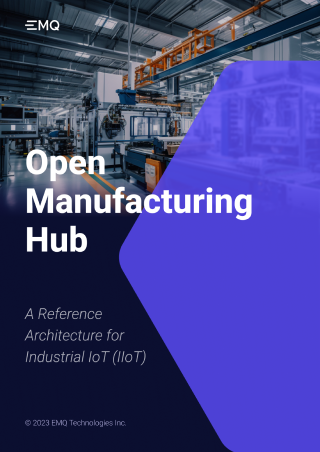Automated KPIs Implementation for Industrial IoT with the Open Manufacturing Hub

Table of Contents
In today's manufacturing environment, achieving operational excellence is a constant pursuit. Key Performance Indicators (KPIs) serve as navigation to guide organizations toward their production goals. However, manual data collection and reporting methods can introduce errors and inefficiencies that hinder the ability to make informed decisions.
In this blog, we will discuss the transformative power of automation through the capabilities of the Open Manufacturing Hub (OMH). Manufacturers can revolutionize the way they monitor, analyze, and optimize their operations.
Challenges of Manually Collecting Data
Determining Overall Equipment Effectiveness (OEE) is critical to production efficiency. Manual data collection (using paper or Excel) is inadequate due to the complexity of automation. Operators focus on smooth operation, not data accuracy, which leads to errors. Software-based solutions provide accuracy, real-time insight, efficiency, consistency and scalability. Integration with systems such as ERP and MES improves data sharing and decision-making. In modern manufacturing, software-based OEE calculation is essential for accurate and efficient assessment.
Choosing the right time period is critical for accurate production metrics. Very short periods of time, such as a day or a shift, produce skewed results due to insufficient data and undue focus on isolated events. Calculating metrics over a longer time span, such as a month, smoothes out productivity and downtime fluctuations and provides more meaningful insights.
The Benefits of an Automated Approach
Automated Approach offers efficiency, accuracy, and improved decision-making. Therefore, the shift from manual methods is crucial for navigating complex environments. Let's delve into the compelling advantages of embracing automation.
Precision through Accurate Data Capture
Manual data entry is prone to human errors that can distort the integrity of KPIs. Automated systems eliminate the risk of inaccuracies by consistently and precisely capturing data. This results in reliable measurements that form the foundation for strategic decision-making.
Consistency in Data Collection
Automation ensures that data is collected consistently across different shifts, operators, and production cycles. This consistency allows for accurate historical comparisons and facilitates the identification of trends and patterns.
Optimizing Human Resources
Shifting from manual data entry to automated solutions frees up human resources for more valuable tasks. Skilled employees can focus on problem-solving, process improvement, and innovative initiatives that drive manufacturing excellence.
Proactive Optimization
Automated systems provide real-time monitoring of KPIs. Deviations from desired values trigger alerts, enabling immediate corrective actions. This proactive approach prevents production disruptions and helps maintain optimal efficiency.
Empowering Real-Time Decision-Making
Manufacturing leaders can access real-time data on KPI performance from anywhere. This empowers them to make informed decisions promptly, based on accurate and up-to-date information.
Efficient Reporting and Communication
Automated systems generate detailed reports on KPI performance, offering insights into production trends and areas that require attention. Additionally, automated notifications keep stakeholders informed about critical developments, ensuring swift responses to issues.
Implementing an Automated KPI Approach with OMH
The Open Manufacturing Hub (OMH) presented by EMQ is a reference architecture for building powerful and scalable Industrial IoT applications that keep your KPIs in control.
Automating KPIs processes by using OMH is a strategic move for boosting efficiency and informed decision-making. This technology-driven approach optimizes operations and cultivates competitiveness in modern business environments.
Selecting Appropriate KPIs
Organizations align KPI selection with strategic objectives, leveraging the capabilities of the OMH to focus on metrics like efficiency, quality, downtime, and production yield.
Leveraging the IT and OT Connectivity of OMH
OMH's IIoT capabilities form the backbone of the automated KPI approach. Its connectivity with machinery, sensors, and data streams ensures comprehensive and real-time data collection.
Seamless Integration with Industrial System
The OMH seamlessly integrates with existing manufacturing systems, promoting a harmonious exchange of data. Integration with ERP and MES systems ensures an unobstructed flow of information.
Customization and Configuration
The OMH can be tailored to capture data that accurately reflects the intricacies of production processes, enhancing the accuracy and relevance of KPI measurements.
Unified Namespace Architecture
The scalable unified namespace architecture of the OMH ensures that as manufacturing operations grow and evolve, the system can seamlessly accommodate increasing data volume and complexity.
Data Governance and Security
The centralized nature of the OMH enhances data governance and security. Access control and data protection measures can be implemented more effectively, safeguarding the integrity and confidentiality of the data used for KPI calculations.

Caution on KPI Implementation
Calculating the KPI score for an entire manufacturing site lacks practicality. While it provides an overview of the site's performance, it does not identify actionable areas for improvement.
To effectively identify weaknesses and drive improvement, a more detailed approach is required. For example, When calculating OEE, start by examining a single pilot machine and collecting comparable metrics. Gradually expand this methodology to individual machines for a more accurate assessment and systematic improvement process.
Reducing KPI analysis to a single value may seem convenient for comparing different production systems or facilities. However, such comparisons often ignore the unique conditions and requirements of each facility, leading to inaccurate conclusions.
These valid comparisons are only useful when evaluating identical machines producing the same product using identical methods. Caution should be exercised when making such comparisons. Instead, use KPI to monitor changes in a machine's productivity over time and fine-tune processes accordingly.
Conclusion
As the manufacturing landscape evolves, the pursuit of excellence remains unwavering. Embracing the automated KPI approach through the OMH bridges the gap between innovation and operational effectiveness. This integration provides benefits such as accurate data collection, consistent measurement, optimal resource utilization, proactive optimization, real-time insights, and efficient reporting. The OMH enables companies to confidently navigate the complexities of modern manufacturing and inspire a culture of continuous improvement and excellence.
